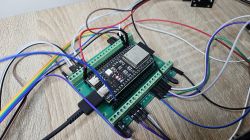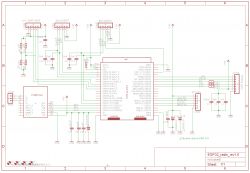@=master= XXL and @robgold
Thank you for your comprehensive reply.
My fault for not specifying what I uploaded, and uploaded the soft from @robgold - "evo2".
List taken care of and now looks nice, thanks to you .
.
Gentlemen I have one more small remark, in the code there is a different pin layout than in the schematic
this is a bit confusing for others (several friends had problems with connecting the card)
In both @robgold (ESP32_radio_evo2) and @Majster XXL (ESP32_radio_v2) there is in the code
lines: 15-18
#define SD_CS 47
#define SPI_MOSI 39
#define SPI_MISO 0
#define SPI_SCK 38
And further in the code it states:
// SPI initialisation with new pins for SD card reader
customSPI.begin(45, 21, 48, SD_CS_PIN); // SCLK = 45, MISO = 21, MOSI = 48, CS = 47
On the other hand, in the schematic :
MOSI 48
MISO 21
SCK 45
--------------------------------------------
Gentlemen, what about the Polish font?
I'm just listening to RMF PRL and the titles are missing Polish characters ( piss them off - at least so it displays the missing letter without the Polish accent)
Unless I something....
I'm now testing saruni's soft with openweathermap - it's OK.
Thank you and best regards
Thank you for your comprehensive reply.
My fault for not specifying what I uploaded, and uploaded the soft from @robgold - "evo2".
List taken care of and now looks nice, thanks to you
Gentlemen I have one more small remark, in the code there is a different pin layout than in the schematic
this is a bit confusing for others (several friends had problems with connecting the card)
In both @robgold (ESP32_radio_evo2) and @Majster XXL (ESP32_radio_v2) there is in the code
lines: 15-18
#define SD_CS 47
#define SPI_MOSI 39
#define SPI_MISO 0
#define SPI_SCK 38
And further in the code it states:
// SPI initialisation with new pins for SD card reader
customSPI.begin(45, 21, 48, SD_CS_PIN); // SCLK = 45, MISO = 21, MOSI = 48, CS = 47
On the other hand, in the schematic :
MOSI 48
MISO 21
SCK 45
--------------------------------------------
Gentlemen, what about the Polish font?
I'm just listening to RMF PRL and the titles are missing Polish characters ( piss them off - at least so it displays the missing letter without the Polish accent)
Unless I something....
I'm now testing saruni's soft with openweathermap - it's OK.
Thank you and best regards














